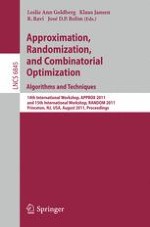This book constitutes the joint refereed proceedings of the 14th International Workshop on Approximation Algorithms for Combinatorial Optimization Problems, APPROX 2011, and the 15th International Workshop on Randomization and Computation, RANDOM 2011, held in Princeton, New Jersey, USA, in August 2011. The volume presents 29 revised full papers of the APPROX 2011 workshop, selected from 66 submissions, and 29 revised full papers of the RANDOM 2011 workshop, selected from 64 submissions. They were carefully reviewed and selected for inclusion in the book. In addition two abstracts of invited talks are included. APPROX focuses on algorithmic and complexity issues surrounding the development of efficient approximate solutions to computationally difficult problems. RANDOM is concerned with applications of randomness to computational and combinatorial problems.
